South Mindarie Trail - Stop 1
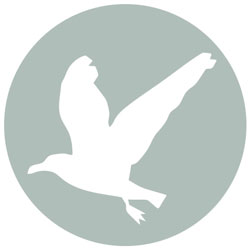
Summary
- The South Mindarie Foreshore retains a sequence of dunes of varying ages which is reflected on ground by a variety of plant communities including two ecological communities listed as priority for conservation by State legislation;
- Coastal dunes provide habitat to a rich diversity of lizards, with 31 different species recorded in dunes between Quinns Rocks and Burns Beach; and
- The foreshore bushland supports numerous species of birds and evidence of other animal species has been observed within this reserve.
Plants and animals
The South Mindarie Foreshore bushland is part of a large conservation area that was set aside due to the unique diversity of plants, animals and landforms retained in this part of the Swan Coastal Plain in the Perth metropolitan region.
While the number of different plants growing within the coastal dunes is lower than the number of plants recorded in other bushland areas on the Swan Coastal Plain, in the Australian context, Western Australia’s coastal vegetation is unique. It includes high number of plants that cannot be found elsewhere. There are 147 species of native plants recorded in the dunes of the Perth metropolitan coast, providing almost year-round flowering, fruiting, seeding and habitat opportunities for the many species of insects, reptiles and birds (Dixon 2011).
Most of the South Mindarie Foreshore area is on Quindalup Dunes, the youngest dunes system of the Swan Coastal Plain. This relatively small area includes the full suite of Quindalup Dunes, from the youngest primary dunes to the oldest (Q4) dunes further east from the beach (See map below).
Off the Alexandria Way and Long Beach Promenade, dunes of older the Spearwood system are represented in this foreshore reserve.
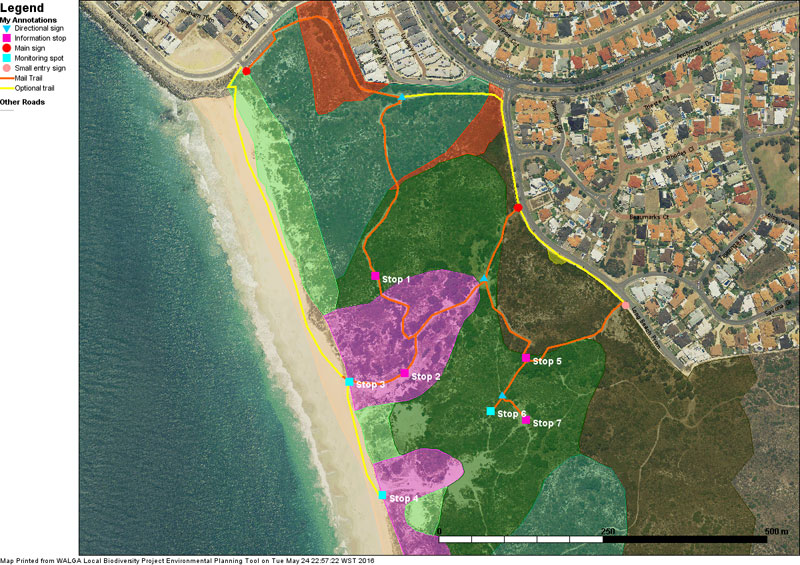
Three main vegetation types were mapped within the site:
- Acacia rostellifera - Melaleuca systena shrublands;
- Olearia axillaris - Scaveola crassifolia shrublands; and
- Spinifex longifolius grasslands and low shrublands.
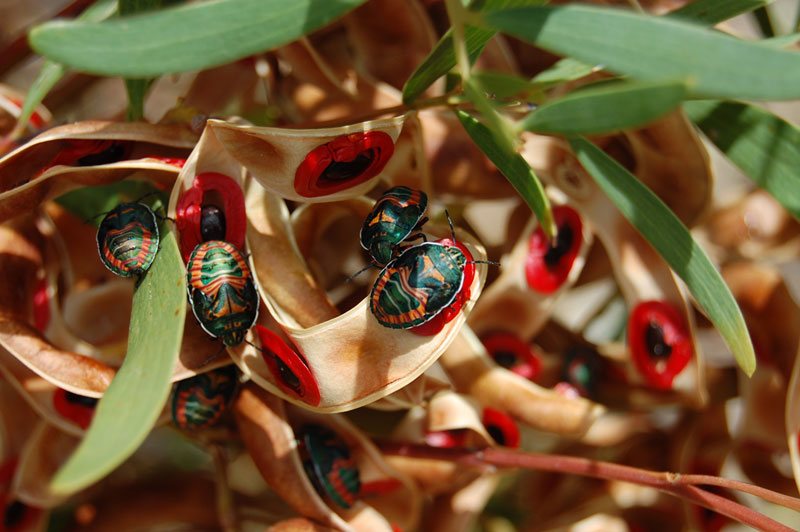
Image: Red-eyed wattle (Acacia cyclops) is one of the most important large shrubs that grow in swales behind the primary dunes. It is rich in associated insects. This species of jewel bug is very well camouflaged with its surroundings while feeding on the seeds of the red-eyed wattle (Powell 2009). Photo courtesy to the Quinns Rocks Environmental Group Inc.
There are two ecological communities and two species of plants that are listed by the Department of Parks and Wildlife as ‘Priority’ ecological communities and ‘Priority flora’. The reasons for this listing are various. The priority ecological communities and priority flora are listed because they are poorly known (Priority 3) (Ecoscape 2004).
Occurrence of Melaleuca cardiophyla is significant as its occurrence here is one of few southern extends for this species.
Priority ecological communities occurring in South Mindarie Foreshore include (EcoLogical 2015):
- Acacia shrublands on taller dunes (Priority 3)
- Coastal shrublands on shallow sands (Priority 3).
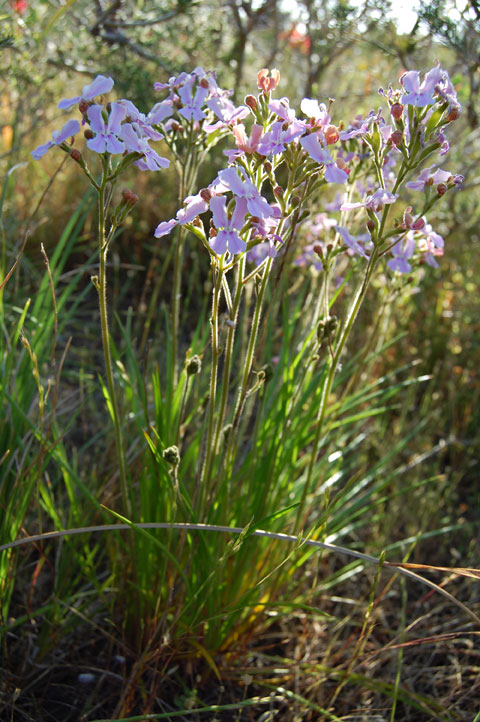
Image: Stylidium maritimum, is a poorly known Priority 3 species and has been recorded in this reserve. Photo courtesy to the Quinns Rocks Environmental Group Inc.
Look out for animal tracks
The youngest coastal dunes of the Swan Coastal Plain have the greatest diversity of reptiles, well represented by legless lizards, skinks and snakes. 31 species of reptiles were recorded within the coastal reserves between Burns Beach and Quinns Rocks.
Elapid or venomous snakes are also known to occur in this area. Therefore it is highly recommended to stay on tracks and wear closed shoes and long trousers when walking through the conservation area. Two species of elapid snakes could occur in this area; Tiger snake and the Dugite.
When you see either of these snakes, stop, turn around and walk (do not run) the other way. Do not attempt to remove or harm the snake.
If you are accidentally bitten, remove yourself from the danger, immobilise the bitten leg or arm, do not move, stay still and call for help. Do not walk home to get help.
Many ground dwelling animals leave behind signs of their presence. You can look out for tracks in sand or diggings.
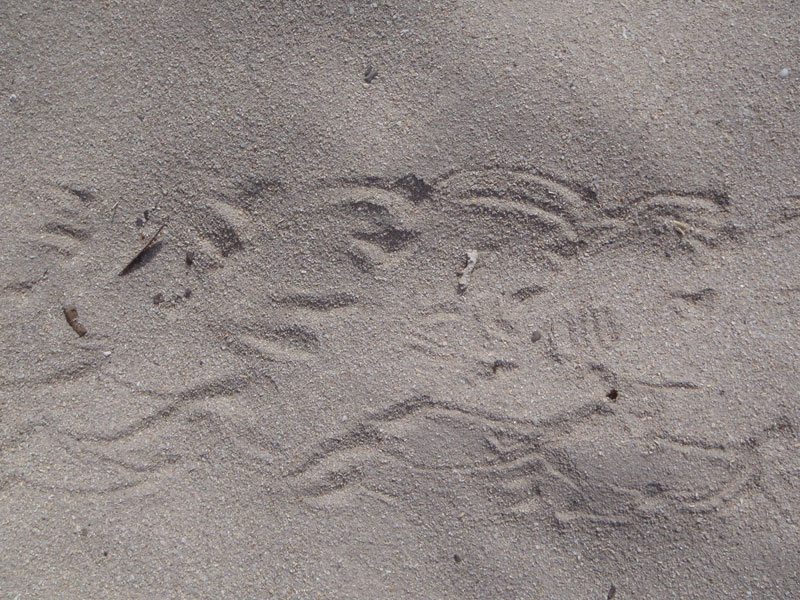
Image: Animal foot prints on a sandy track. These look like Echidna tracks. Photo courtesy to the Quinns Rocks Environmental Group Inc.
Four native mammals were recorded in the coastal bushland between Burns Beach and Quinns Rocks, including two significant species:
- Western Brush Wallaby (Macropus Irma) - Compared with the similar Western Grey Kangaroos, the Western Brush Wallaby numbers declined significantly in the Perth Region but also across its original range. This is primarily due to loss of habitat and fox predation.
- Honey possum (Tarsipes rostratus) (Ecoscape 2004) – unique nectar eating marsupial. It only lives in the South West of Western Australia, it is short lived and requires a year round sources of flowering plants to survive. Watch this YouTube video of Honey Possum feeding: https://www.youtube.com/watch?v=Y1CjINN38Jc
In the heathlands nearest to the coast, 26 birds species were recorded, including birds that are now extinct from most of the metropolitan coastal areas. Significant bird species that were recorded here include the White-winged Fairy Wren, White-Bowed Scrubwren, White-breasted Robin, New Holland Honeyeater and Carnaby’s Black Cockatoos. Five species of migratory birds protected through international agreements were also recorded in the study area.
The full list of birds observed in the coastal bushland is below:
- Nankeen Kestrel Falco cenchroides
- Silver Gull Larus novaehollandia
- Laughing Turtle-Dove Streptopelia chinensis
- Carnaby's Black Cockatoo Calyptorhynchus banksii
- Galah Eolophus (Cacatua) roseicapilla
- Australian Ringneck Barnadius zonarius
- Splendid Fairy Wren Malarus splendens
- White Winged Fairy Wren Malarus leucopterus
- White Browed Scrub Wren Sericomis frontalis
- Western Thornbill Acanthiza inomata
- Yellow Rumped Thornbill Acanthiza chrysorrhoa
- Red Wattlebird Anthochaera carunculata
- Little Wattlebird Anthochaera lunulata
- Singing Honeyeater Lichenostomus virescens
- Brown Honeyeater Lichmera indistincta
- New Holland Honeyeater Phylidonyris novaehollandae
- White Cheeked Honeyeater Phylidonyris albifrons
- Western Spinebill Acanthorhynchus superciliosus
- Scarlet Robin Petroica multicolor
- White Breasted Robin Eopsaltria pulverulenta
- Rufous Whistler Pachycephala rufiventris
- Grey Fantail Rhipidura fuliginosa
- Willie Wagtail Rhipidura leucophrys
- Black Faced Cuckoo Shrike Coracina novacholiandia
- Dusky Woodswallow Artamus cyanopterus
- Grey Butcherbird Cracticus torquatus
- Silvereye Zosterops lateralis
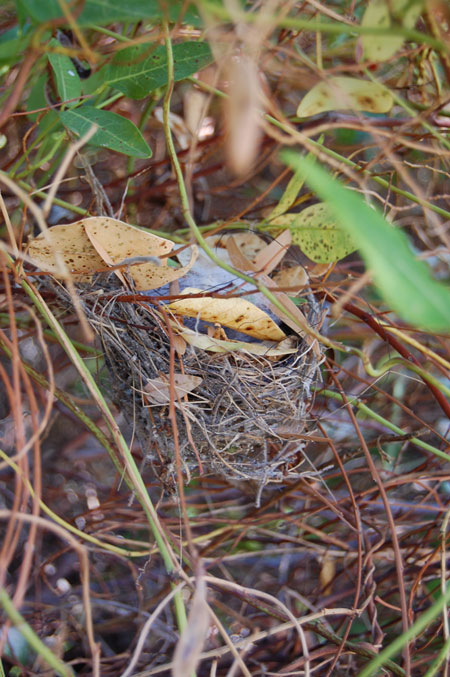
Photo courtesy to the Quinns Rocks Environmental Group Inc.
REFERENCES
- Dixon, K. (2011) Coastal Plants. A guide to the identification and restoration of plants of the Perth region. Cambridge Coastcare.
- Eco Logical (2015) Environmental Vulnerability Assessment. In: mp rogers & associates: Coastal vulnerability study and hazard mapping. City of Wanneroo
- Ecoscape (2004) Foreshore Management Plan Mindarie - Quinns Rocks, City of Wanneroo
- Powel, R. (2009) Leaf and Branch. Trees and tall shrubs of Perth. Department of Environment and Conservation, Perth.